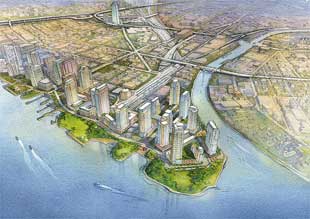By Jeremy Walsh
The 5,000-unit Hunters Point South development will proceed with a hike in the eligible income level for affordable housing , drawing the ire of housing advocates, who claimed the development's rent-subsidized units are still beyond what most Queens residents can afford.
Community Board 2 Chairman Joseph Conley scheduled a May 28 meeting with a coalition of housing groups, including Queens Community House, after they brought roughly 50 people to a public hearing last Thursday to complain about the price level of the new housing.
Some 60 percent of the units will be earmarked for affordable housing, representatives from the city Economic Development Commission said during an April 21 public hearing. How many of the units would be rentals and how many would be for private ownership has not been determined, though EDC officials said the majority will be rentals. Conley said CB 2 has insisted an ownership component is crucial.
The apartments would be available to households with an annual income between $55,000 and $168,000, starting at $700 a month for a studio. The income eligibility range was previously between $50,000 and $145,000 for a family of four, but this was changed when federal Housing and Urban Development guidelines were updated for 2008, EDC officials said.
“Half of Queens is effectively excluded,” said Elena Conte, an organizer with the Pratt Center for Community Development, noting the median household income in Queens was $45,000 in 2005.
The project will be built on 30 acres of land along Long Island City's waterfront just south of the upscale Queens West condominiums. The EDC, which hopes to create a nonprofit entity to issue tax-exempt bonds to finance the construction, needs to rezone the land to allow for the residential buildings. The Real Estate Board of New York has offered to serve as the development advisor for the project.
Construction on the housing component is expected to start around 2011, with work concluding in 2017, EDC officials said.
Conley was optimistic about the project, largely because of the measure of public input.
“The community was basically locked out of Queens West,” he said. “It means a lot to do this.”
Conte advocated earmarking at least 50 percent of the units for households earning below the median income and suggested combining housing for low-income people with affordable housing units.
“It's not one against the other,” she said. “You simply have to have the technical and political will to do it.”
Other advocates warned the income level for the affordable housing ignores problems faced by many Queens residents especially immigrants.
“Over one-half of Queens households pay more than 30 percent of their income for rent,” said Karen Smith, a tenant organizer with Queens Congregations for Action. She pointed out that many people live in severely overcrowded conditions, with as many as 10 people sharing a single apartment.
But Conley warned that modern, large-scale redevelopments must be profitable to make it past the planning phase.
“You have to find the right ratio to make it work,” he said of the mix of market-rate and subsidized housing.
Conley also said CB 2 wants a voting seat on the board of directors if the EDC succeeds in creating a nonprofit entity. The EDC said they were “working toward that.”
Residents also worried the project would draw too much power from the electricity grid and eliminate a much-used dog run at the site.
Reach reporter Jeremy Walsh by e-mail at jwalsh@timesledger.com or by phone at 718-229-0300, Ext. 154.































